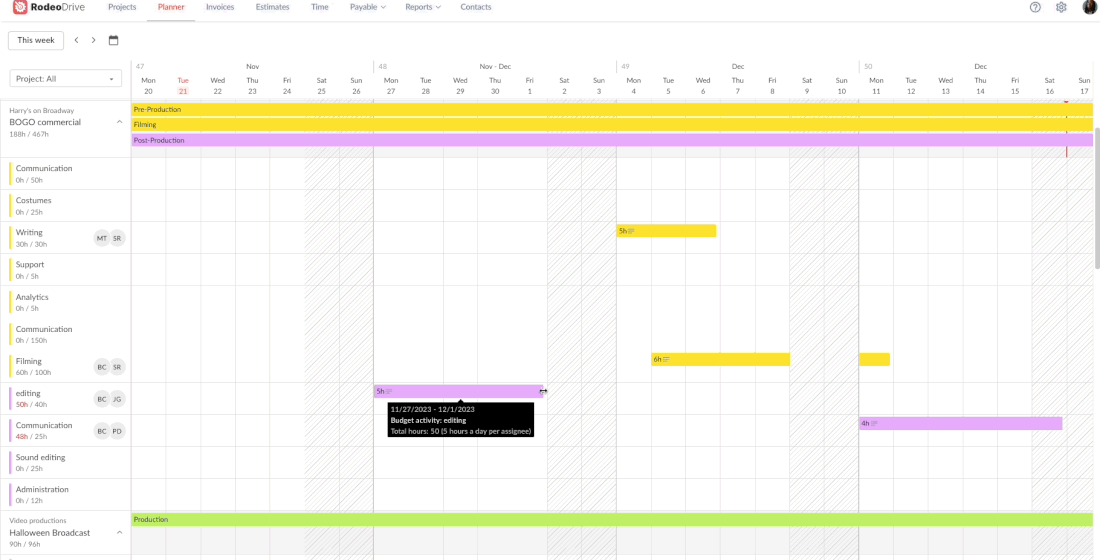What Is Level of Effort (LOE)? A Step-by-Step Guide
Task management is a crucial part of project management, but some tasks require more effort than others. This is where Level of Effort (LOE) comes in.
As we’ll cover in this article, Level of Effort refers to the more behind-the-scenes support tasks that are necessary but not immediately obvious during project planning.
Nonetheless, it’s crucial to estimate LOE at the beginning of a project to better understand whether timelines, costs, and task assignments are realistic. Let’s jump in.
What is Level of Effort (LOE)?
A project’s Level of Effort — often shortened to LOE — is a project management term that refers to the support activities required for the successful completion of the project’s primary tasks.
Whereas a project’s main tasks are the ones that directly correspond to progress toward the ultimate objectives or deliverables, support activities often have no measurable results of their own. For instance, support activities often include tasks like stakeholder communication, submitting expense reports, and updating project documentation.
Although support activities are a necessary part of project management, they must be completed on top of other project tasks. Tasks with a high level of effort typically take longer to complete, which is why it’s a good idea to calculate LOE early on, that way you know how much work each part of the project requires.
Level of Effort examples in a project
LOE tasks are typically tied to a primary project task. For example, you might need to order materials before your team can begin working on a particular project phase.
These support activities are oftentimes tedious and can eat away at valuable team time. This is why teams with enough resources often enlist the help of administrative assistants or other support staff who have more time to spend on LOE work.
If not though, your team will need to tackle these tasks themselves. In fact, you might be working on support activities as part of your day-to-day work without even realizing it.
Here are a few examples of Level of Effort activities:
Example: Updating project documentation
Project documentation typically involves collecting records, files, and other documents that provide relevant information on project decisions and outcomes. The goal of this documentation is to create a historical record for the project, which can later be referenced for insights into why particular decisions were made, should stakeholders have any questions. This is a LOE activity that can be tedious but necessary for many projects.

Example: Communicating with stakeholders
Big decisions your team makes while working on primary tasks should be promptly relayed to stakeholders. This can make big decisions into high LOE activities, as your team will need to dedicate time to communication, which can be rather time-consuming when you need to hold a meeting with clients or stakeholders.
Check out our guide to project communication management for helpful tips.
Example: Submitting expense reports
It’s impossible to properly track your project budget if your expenses aren’t properly accounted for. If your team doesn’t have an administrative assistant to help out, then this support activity might very well fall on the project manager’s plate.
Example: Equipment maintenance
Depending on the nature of your project, your team might be using equipment that requires regular maintenance. This is certainly a support activity to take into account when measuring Level of Effort, as technical pieces of equipment may involve maintenance processes that are rather extensive.
Example: Updating reports
Compiling project progress reports is a critical task for project managers. Accurate reports allow them to determine whether the budget and project schedule are on track or if adjustments need to be made.
.png)
But although this is a crucial project activity, reporting doesn’t directly relate to a project’s primary objectives, which is why it can be categorized as a support activity.
Level of Effort in project management: Why calculate LOE?
Not all tasks are created equally, as each requires a unique Level of Effort in the same way it might require funding or specific materials. But while funding or materials are often closely monitored, effort too often gets ignored.
Teams that take the time to calculate the Level of Effort for their tasks are able to better prioritize tasks and estimate project timelines more accurately. Plus, projects that come with a high level of effort tend to take longer, which can increase project costs.
When you calculate the LOE early on, you can ensure that clients, stakeholders, and your project management office are on the same page regarding what the project will cost and how long it will take. This way, there will be no surprises.
When to measure and assess LOE
Generally, estimating Level of Effort is one of the main responsibilities of a project manager. It’s always best to measure the LOE for your project tasks during the planning phase when things are being developed. This way, task assignments can always be reshuffled based on the amount of work involved.
However, you definitely want to have your project scope and requirements solidified before starting on any LOE calculations. Level of Effort is often dependent on the conditions your team will be working in, so you want to make sure you have an accurate sense of the project environment first.
How to calculate LOE
Because Level of Effort can be more of an abstract concept, there’s not just one way to calculate it effectively. Instead, there are a couple of different techniques you can use depending on your project scope.
In general, though, it’s simplest to represent Level of Effort as a measure of time. This is usually a measure of how long the extra effort will take you or your project team to complete.
Here’s a look at each effort estimation technique to help you gauge whether a task has a low or high Level of Effort:
Sort tasks based on their impact on project objectives
In general, you want your tasks with the highest impact on project objectives to be completed with the utmost accuracy and care. This often means these tasks require a high Level of Effort.
This method involves sorting your tasks based on the level of impact they have on your deliverables or objectives. The easiest way to do so is by categorizing them by low, moderate, or high impact, and then comparing each task within each category based on the Level of Effort and involvement of each.
Rank your tasks by priority
Instead of looking at the impact of tasks on overall project objectives, you can also examine them through the lens of priority. Some tasks cannot be started until other tasks are completed.
As such, you might want to create a list of all your project tasks and then rank them by priority, with the tasks at the top of the list being the most urgent ones that take the most effort to complete.
Attribute a numerical value to each task
If categorizing isn’t a technique that works for you, you may want to consider adopting an effort scale for measuring.
One way to do this is by assigning a number to each project task — either ranging from 1-5 or 1-10 — where the highest number indicates that a task requires maximum effort, whereas low numbers are for tasks that only need minimal effort.
The benefit of this system is that it might be easier to distribute high-effort tasks among team members more equally. For instance, each team member would have a few tasks with high numbers and a few low-numbered tasks to keep things balanced.
Best practices for utilizing Level of Effort
Level of Effort should never be calculated in a vacuum, as context is so important in determining how much work a project will require. Here’s a glance at three best practices to consider before you gauge LOE for a project.
Determine how precise your estimates need to be
When you’re actually estimating Level of Effort, you should consider how accurate your effort predictions need to be. For example, if your project timeline is extremely tight, then poorly estimated LOE figures might have severe consequences.
On the other hand, general estimates might be sufficient for projects that don’t require a lot of behind-the-scenes work.
Consider your team’s skills and experience level
Taking your team’s skills and experience levels into account when estimating your project LOE is one of the best ways to guarantee that your estimations are accurate.
If your team is working on a project in an industry that’s completely unfamiliar to them, they’ll more than likely experience a learning curve. As the project manager, this might mean that you’ll need to dedicate more time to quality control and double-checking everyone’s work — requiring more effort on your end.
Compare to the LOE required for previous projects
Looking at the successes and challenges of previous projects goes a long way in determining the LOE for a new project with a similar scope.
You can do this type of comparison by examining past project documentation or meeting with PMs who have successfully completed a project with comparable requirements to get a sense of how much work was involved during each project stage.
LOE pitfalls and challenges
Again, Level of Effort is only helpful if it’s relatively accurate — which can be a challenge for some project managers.
Here are some key challenges to be aware of and avoid to ensure your effort is appropriately calibrated:
- Not allocating extra time to account for estimation inaccuracies.
- Failing to relay the estimated Level of Effort of a particular task before a team member starts working on it.
- Forgetting to revise LOE estimates as the project progresses.

How project management software can help with LOE
Much of the LOE work that project managers have on their plate relates to project administration, whether that’s submitting expenses, updating reports, or invoicing clients.
Luckily, there are many all-in-one project management tools out there — such as Rodeo Drive — that can automate some of these processes for you.

Here’s an overview of some of Rodeo Drive’s key features:
- Build phase-based budgets: Effortlessly create a budget in just a few clicks. Once you’re done, you can even send your budget estimate directly to your client for approval.
- In-app time tracking: Forget wasting valuable hours on timesheets. Rodeo Drive enables you to record time as you work or add a timecard after the fact.
- Invoicing: Gone are the days of manually putting together invoices. Rodeo Drive can automatically generate them for you based on the project progress your team has made. Plus, you can customize your invoices with your own branding and terms and conditions. Send them from Rodeo Drive in the UK or via QuickBooks in the US.
- Reporting: Are you constantly fielding stakeholder questions on your project progress? Rodeo Drive instantly brings all of your data together for an insightful look at your team’s productivity.
After all, why wouldn’t you implement a tool that makes your life easier? Try Rodeo Drive for free today.








